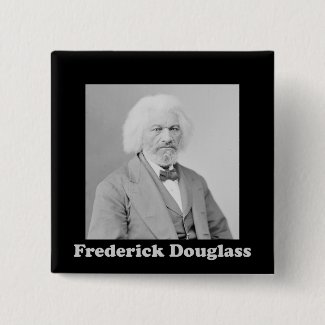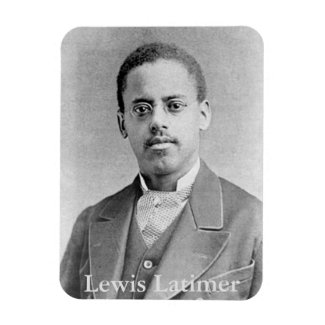Lewis Howard Latimer was born September 4, 1848 in Chelsea, Massachusetts to former slaves. As a teen, he joined the United States Navy to fight against slavery during the Civil War. After the war, he became an office assistant in a patent law firm. Upon learning that Latimer had the skills of a draftsman, which he taught himself from used books, he was promoted to junior draftsman at the patent law firm. Eventually, Latimer was promoted again to senior draftsman.
As a draftsman at the patent law firm, Latimer's job was to make technical drawings to submit with the patent applications of the firm's clients. His employment there put Latimer in place for the accomplishment he probably most known and remembered for. Latimer worked closely with Alexander Graham Bell, a client of the patent law firm, to produce the drawings for Bell's patent application of the telephone. Latimer had to work both quickly and accurately since both he and Bell knew there were other inventors trying to patent a device that would carry sound over wires. By submitting Bell's patent application just hours before a competitor, Latimer cemented Bell's place in history.
Latimer became an inventor in his own right. His first patent was an improved restroom compartment for trains. However, his major achievement as an inventor was an improvement on another invention, the light bulb. The filament in the first incandescent light bulbs did not last long enough for practical use. Latimer invented and patented an improved carbon filament that stayed lit long enough for the light bulb to be useful.
In his later years, Latimer went to work for Thomas Edison. With his knowledge of both patent law and electrical engineering, he helped Edison's company defend itself against lawsuits. While employed by Edison, Latimer also wrote a definitive book on incandescent lighting.
Our Story: A Celebration of African-American History
Celebrating the people and events of Black History in America
Wednesday, February 28, 2018
Monday, January 15, 2018
Events Celebrating the Bicentennial of Frederick Douglass' Birth
2018 is the bicentennial of Frederick Douglass' birth. Many celebrations have been planned to honor the 200th anniversary of the famed orator's birth. Here are some events that are happening in Washington DC and Maryland, the areas in which Douglass spent much of his life.
Anne Arundel county plans to celebrate throughout the year with numerous events, including conversations on race in January and February. Other highlights are a Family Day to honor Douglass on February 24, a gospel concert, and a culinary historian's lecture on being a black chef in the 18th and 19th centuries.
In Baltimore, the Lewis is marking the occasion on February 10, while the Baltimore Civil War Museum is giving visitors an opportunity to "meet" Frederick Douglass during the Civil War. Also in Baltimore the Frederick Douglass Bicentennial Book Fair is slated for February 24
The National Park Service is celebrating the occasion with a party on February 17th and 18th from 10 am to 4 pm at Douglass' home in Anacostia.

Picture of Frederick Douglass
by redbook
Anne Arundel county plans to celebrate throughout the year with numerous events, including conversations on race in January and February. Other highlights are a Family Day to honor Douglass on February 24, a gospel concert, and a culinary historian's lecture on being a black chef in the 18th and 19th centuries.
In Baltimore, the Lewis is marking the occasion on February 10, while the Baltimore Civil War Museum is giving visitors an opportunity to "meet" Frederick Douglass during the Civil War. Also in Baltimore the Frederick Douglass Bicentennial Book Fair is slated for February 24
The National Park Service is celebrating the occasion with a party on February 17th and 18th from 10 am to 4 pm at Douglass' home in Anacostia.

Picture of Frederick Douglass
by redbook
*This site is not affiliated any of the organizations mentioned in this post. Purchases made from this site do not benefit said organizations.
Friday, October 27, 2006
Sarah Parker Redmond's Unusual Life
Sarah Parker Redmond led a life that was extremely unusual for African-American women of her times. Born into a financially secure family in 1824, Redmond would grow up to become abolitionist. As one of several African-Americans who was employed as an agent of an abolitionist society, she lectured in the northeast United States and Canada. In 1859, Redmond left for England and gave anti-slavery lectures there and later also included Ireland and Scotland on her circuit. Redmond eventually settled in Italy where she lived until her death in 1894.
Wednesday, October 25, 2006
Harriet Tubman Implements Strategies on the Underground Railround
Widely-known for leading over 300 slaves to freedom as a conductor of the Underground Railroad, Harriet Tubman used clever strategies that led to her remarkable success. For instance, she would leave on a Saturday night because escaped slave notices couldn't be published until Monday.
Tuesday, October 24, 2006
Abolitionist Harriet Jacobs publishes account of slave experiences
Abolitionist Harriet Jacobs published her experiences as a slave in Incidents in the Life of a Slave Girl under the pen name Linda Brent. In the book, she recounted how she spent seven years hiding in a dark crawl space that measured approximately nine feet long and seven feet wide. The crawl space had a sloping ceiling that was three feet high at its largest end.
Monday, October 23, 2006
Sojourner Truth Brings Court Case to Free Son

Famed abolitionist Sojourner Truth, with the help of the Quakers, sued to free her son Peter who had been illegally sold into slavery. Peter was to be emancipated under the law of his state of residence (New York). Instead the 5-year-old was sold to an Alabama owner. The court process took several months, but Truth prevailed and Peter was returned to her.
New feature: Theme of the Week
This week we're introducing a new feature, the Theme of the Week. This week's theme is women in the abolitionist movement.
Friday, October 20, 2006
Senator Blanche K. Bruce
Blanche K. Bruce was the first African-American to serve a full term in the United States Senate. Republican Bruce represented Mississippi from 1875 to 1881. (Hiram Revels was the first African-American senator when he completed the term of former senator Jefferson Davis.)
Subscribe to:
Posts (Atom)
